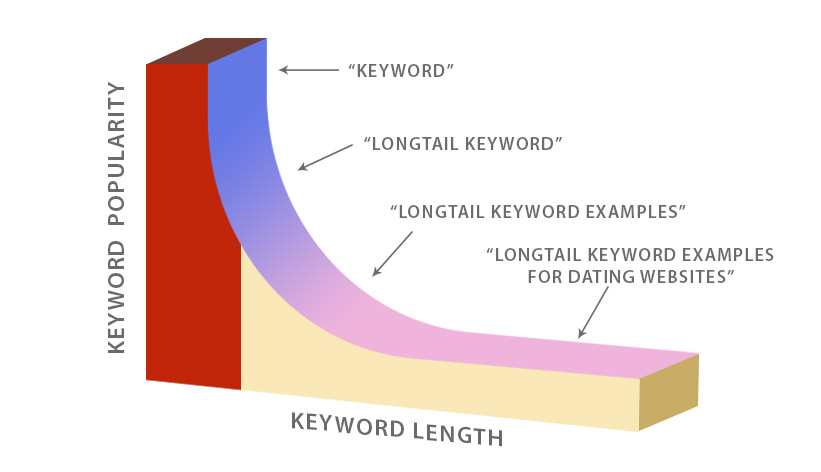How to Drive Quality Traffic to Your Website: Use Long Tail Keywords
In hopes of increasing traffic to their websites, many new businesses hire SEO specialists to create well-written content packed with the most popular keywords off Google Adwords. Still, many of these excellent pieces fail to show up on the first one hundred pages on search engines. Either that or they attract plenty of visitors but don’t generate any conversions.
You’ve probably been in this situation before. Whilst you were pretty sure you and your content strategy team did your SEO homework, you may have inadvertently left out one important factor that will boost quality traffic to your website and consequently, profit: the long tail keyword.
Head Terms VS Long Tail Keywords
In order to understand the long tail keyword, it would be better to first define the other type of keyword: the head keyword, also known as the head term.
Head keywords refer to commonly used terms. They are relatively short, usually up to 25 characters or up to three words, as in the example ‘Australian beaches.’ This combination of length and search popularity makes head keywords highly visible and competitive.
Long tail keywords, as the name suggests, are longer. They are also more specific, as in ‘kid friendly restaurants South Wharf Melbourne.’ Unlike head terms, long tail keywords don’t generate high search volumes, so the competition is low.
If long tail keywords rank low on search queries and don’t bring you a lot of visitors, why should marketers capitalise on them? How will long tail keywords drive enough traffic to your website?

Head Terms VS Long Tail Keywords: The shorter the keyword, the more popular it is. However, the longer the keyword, the more specific it becomes, and the better traffic it gives your site in terms of leads and conversions.
The Problem With Popular Keywords
When it comes to boosting website traffic, many businesses new to search engine optimisation are blinded by quantity. The higher the search volume, the more traffic to your website, the better chances of conversion, right?
Not always.
To begin with, getting first page ranking for the most popular head terms is a gargantuan undertaking, especially if you’re a new player. With more than 200 SEO ranking factors to hurdle and well-established websites to compete with, fighting for the top position may take time and effort and therefore may not be worth the investment.
Suppose you did earn a good spot for your chosen head term, say, ‘surfboards,’ and it brought in a lot of traffic to your website. Sure, a fraction of these visitors might be thinking about buying. However, some might actually be thinking about ‘the definition of a surfboard,’ ‘standard surfboard measurements,’ or even ‘how to stand on a surfboard.’
Moreover, those who are shopping for surfboards didn’t indicate whether they want a store in Sydney, Perth, or Gold Coast or whether they need something off the rack or custom-made. As a result, those who don’t find what they’re looking for will be out of your website in seconds. There goes your chance at converting and maintaining your search position–because you very well know that a high bounce rate (the percentage of visitors navigating from your site after viewing only one page) will kick you off your current ranking.
What you need to remember time and again is that search popularity does not necessarily translate to profit. Therefore, you and your marketing team should invest in increasing quality, not quantity, traffic.
Get your focus back on quality traffic. Get Xortie
The Long Tail Keyword and Quality Traffic
By ‘quality traffic,’ we mean visitors:
- whose needs perfectly match what your page or website is offering.
- whose questions can be answered by the information you provided online.
- who are most likely interested in transacting with you.
As demonstrated in our surfboard example, concentrating on head keywords will bring in a mix of people whom you may not be able to satisfy and therefore convert. With a more detailed keyword, on the other hand, you are actually sifting through that mix for only those who are targeted by your content strategy goals. Your visitor base won’t be as large, but don’t let that bother you too much. By using a long tail keyword, you have created a specific niche, improving your chances of engagement and conversion in the long run. So between ‘surfboards’ and ‘affordable custom-made surfboards Gold Coast,’ the latter would be a much profitable choice.
Buyer Intent: Your Guide to Crafting Your Long Tail Keyword
As said earlier, you have to put yourself in the shoes of those who are most likely to be interested in what your business has to offer. Then incorporate their needs into your keyword research.
Aside from creating a profile of your target buyers, one of the ways to guide your long tail keyword choice is to collect input from customers and prospects. Let’s say you run a print shop in Sydney: what do clients usually enquire about? Knowing buyer intent is key to crafting the most appropriate long tail keyword for each unique content.
For instance, do a lot of your customers ask about which print finishing is the best for their projects? Answer their question with keyword ideas related to comparing different print finishings. Do they solicit advice on their final art? Long tail keywords that begin with ‘how to’ or ‘tips’ might grab their attention. Or are they just shopping around for the least expensive price? Then look at keyword ideas that describe your rates such as ‘affordable digital printing in Sydney CBD.’
It pays, therefore, to work closely with your SEO and content marketing people. When your team is aware of who is being targeted, they’ll be able to visualise what these people type on the search engine field. Thinking like the customer will make long tail keyword identification a breeze. And when you have the perfect long tail keyword, content optimised for quality traffic– and profit–will slowly but surely follow.


